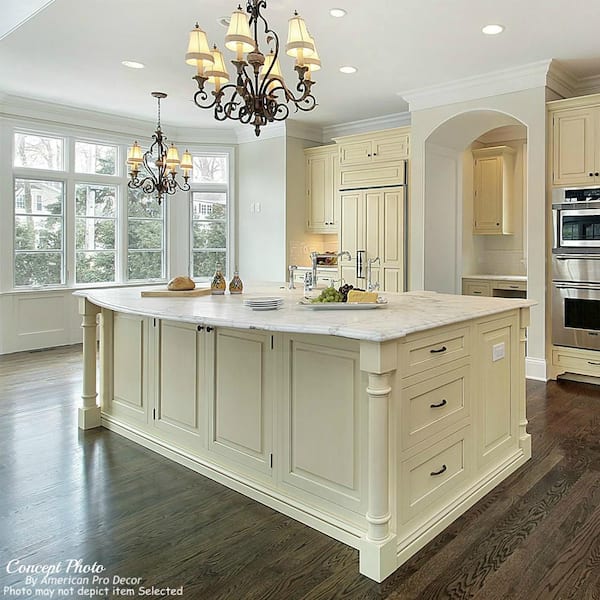Important Elements to Consider When Selecting Legs For Cooking Area Island
Choosing the appropriate legs for a kitchen area island entails a cautious analysis of multiple aspects that can significantly influence both capability and aesthetic charm. As we discover these elements, it ends up being clear that each choice can have far-reaching ramifications for the total kitchen experience.
Material Options
When choosing legs for a cooking area island, understanding the different product alternatives is important for accomplishing both visual allure and structural stability (Legs For Kitchen Island). The option of product significantly influences not only the toughness of the island yet also its overall style and performance
Metal legs, frequently made from stainless steel or wrought iron, contribute a commercial and modern-day feeling while making sure toughness and security. These materials are resistant to wear and can sustain significant weight, making them suitable for bigger islands.
One more option is engineered products, like MDF or plywood, which can be a lot more economical while still providing a range of finishes. Nonetheless, they might not offer the same degree of security as solid timber or steel. Products such as acrylic or glass can produce a contemporary appearance, though they may call for extra support to make sure stability.
Inevitably, the choice of material for cooking area island legs ought to straighten with the preferred functionality and the general theme of the cooking area.
Design And Style

When taking into consideration design, the form and coating of the legs are critical. Conical legs can supply a feeling of agility and sophistication, while thicker, extra durable legs can share stamina and security. Furthermore, the surface-- be it painted, stained, or natural-- need to complement the kitchen cabinetry and kitchen counter products to develop a unified look.
Additionally, the style of the legs can also reflect individual preference. Custom-made or ornamental legs, such as those featuring intricate makings or one-of-a-kind geometric forms, can function as centerpieces, including personality and character to the kitchen area. Inevitably, the appropriate option will not just boost performance but additionally raise the aesthetic allure, making the cooking area island a standout function of the home.
Height Factors To Consider
Selecting the appropriate height for cooking area island legs is important, as it straight impacts both performance and convenience. The conventional elevation for a kitchen island normally ranges from 36 to 42 inches, lining up with usual countertop heights.

It is additionally necessary to represent users' elevations and choices. Personalizing the elevation can make sure a comfortable experience for all member of the family, making the kitchen island an extra useful and pleasurable room.
Weight Support
Ensuring ample weight support for cooking area island legs is important for both safety and performance. The kitchen island commonly serves numerous purposes, consisting of food preparation, eating, and added storage, demanding a robust assistance framework. When choosing legs, it is critical to think about the total weight capacity needed based upon the island's intended usage and the products that learn this here now will be put on it.
The selection of material for the legs plays a considerable duty in their weight-bearing abilities. Strong timber, metal, and durable compounds generally offer premium strength compared to lighter products. In addition, the design of the legs-- whether they are directly, tapered, or have a pedestal type-- can affect their ability to distribute weight successfully throughout the framework.
Always speak with the producer's specs concerning load limits to ensure that the legs can sustain the desired weight without endangering safety and security. In recap, choosing kitchen area island legs with sufficient weight support is essential for developing a secure and practical cooking room.
Setup and Maintenance
Appropriate installation and upkeep of kitchen island legs are important for guaranteeing read here long life and stability. This usually includes safeguarding the legs to the island base utilizing ideal fasteners, guaranteeing that the legs are degree and aligned.
When installed, routine upkeep is required to maintain the integrity and appearance of the legs - Legs For Kitchen Island. For wood legs, periodic cleaning with a wet cloth and application of appropriate wood polish can avoid moisture damage and keep their finish. Steel legs might require a gentle cleansing solution to eliminate oil and crud, complied with by a completely dry towel to avoid corrosion development
Furthermore, check the legs regularly for signs of wear or damage, such as fractures or loose joints. Tightening screws or bolts as needed can likewise extend the life expectancy of the legs. By sticking to these setup and upkeep methods, house owners can make certain that their cooking area island continues to be tough and aesthetically appealing for several years ahead.
Verdict

Aesthetic comprehensibility is extremely important in selecting the style and design of legs for a kitchen area island, as these components substantially influence the overall ambiance of the area. Tapered legs can supply a feeling of agility and style, while thicker, extra robust legs can convey strength and stability.Choosing the suitable height for kitchen area island legs is important, as it straight affects both performance and convenience. In summary, choosing kitchen area island legs with adequate weight support is important for creating a safe and functional cooking room.
In verdict, picking legs for a cooking area island requires cautious consideration of various factors, including product choices, style, height, weight support, and installment.
Comments on “Ingenious and Stylish Layouts in Modern Legs For Kitchen Island Solutions”